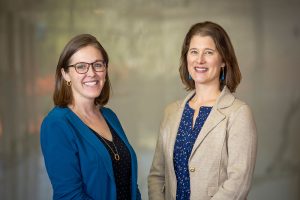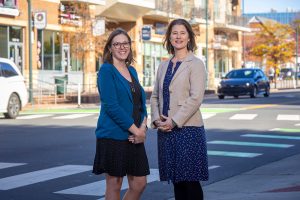Laura Sandt and Caroline Mozingo have been appointed permanent co-directors of the Highway Safety Research Center, bringing a combined 33 years of experience in driving success in research, outreach, and operations.

As leaders of the Highway Safety Research Center (HSRC), Laura Sandt and Caroline Mozingo will equally share oversight and managerial responsibility of the center, including activities related to fiscal management, human resources, strategic planning, and coordination with University leadership. Other areas will be divided, with Sandt overseeing research strategy and implementation, and Mozingo leading strategic communications, partnerships, and operations.
Sandt and Mozingo have served as interim co-directors of the center for the past two years, establishing this effective and successful shared leadership model. UNC Research spoke to the pair about their career, research, and goals for HSRC.
How did you get involved with highway safety research?
LS: I was first introduced to highway safety research when I was completing my undergraduate degree at Texas A&M University and began working as a research assistant helping to prepare manuscripts for a research center that focused on transportation. The subject matter interested me so much that I decided to pursue a career focusing on transportation and injury prevention. I came to UNC-Chapel Hill to join the master’s program in City and Regional Planning (DCRP) in the College of Arts and Sciences, and from there I got my PhD in Epidemiology from the Gillings School of Global Public Health.
CM: I’m a communicator by training (UNC Hussman School of Journalism and Media grad here) who initially joined HSRC because I wanted to work on research projects and safety programs that positively impacted real people and communities. The passion of my HSRC colleagues and our partners — we call it the HSRC Family — paired with the challenge and importance of our projects is what keeps me here.
How has your role changed at HSRC?
LS: My role has changed a lot since I began here in 2004 as a graduate research assistant. My early years at HSRC were focused on developing a foundational knowledge of the transportation field, public health approaches to injury prevention, and growing my research and analysis skills. As co-director, I still have the opportunity to lead research, but my focus is on finding strategic ways to achieve our center’s broader mission, which is to improve road safety in the U.S. and reduce the burdens placed on disadvantaged communities by cultivating multidisciplinary research, education, and professional development.
CM: I was initially hired to work on a project geared toward improving safety for kids walking and biking to school. Over the past 14 years, I’ve worked on projects across almost every transportation topic you can think of — from teen driver safety to roadway design issues for engineers to training for practitioners — most of which had an application and impact on real people and communities. While I still do some of that work, more of my time is now spent working to support HSRC staff and thinking about how to build relationships and partnerships for researchers and the center as a whole.
 Why is highway safety research important?
Why is highway safety research important?
LS: People use the transportation system literally every day, often without thinking of it. Because it’s so mundane, we often take it for granted. But we still see more than 40,000 people killed each year on our nation’s roadways, and we have a lot of work ahead of us to understand and address the root causes of traffic violence.
CM: Highway safety is a challenging and exciting research field that impacts the safety — and lives — of so many people every single day. Whether you’re getting from one place to another by car, bus, bike, foot, or by some other mode of transportation, research can be used to help make that trip safer.
LS: The transportation field is also very dynamic and rapidly changing, with huge disruptions happening in the last decade such as ridesharing systems like Uber, micro-mobility systems like e-scooters, and vehicle electrification and automation systems like what we see with Tesla. The innovations demand that researchers keep pace in order to understand the impact of these changes on roadway safety, health, and quality of life for our society.
What are your goals for HSRC?
LS and CM: We’re thrilled to take on the co-director roles at HSRC. In ongoing conversations with center researchers and colleagues, we’ve already defined some clear priorities, including:
- continue supporting the great people and the great work being done at HSRC;
- grow collaborations and partnerships for multidisciplinary transportation research and expand HSRC’s connections to UNC System researchers, faculty, and students;
- expand efforts to train and place future professionals in transportation careers; and
- foster opportunities for increased community engagement, specifically through road safety programs we’re involved with across North Carolina.
We strive to help more people make the connection between transportation and community issues such as access to health care, equity, climate change, and others. Our ultimate goal is to increase the number of people who are aware of road safety issues and are part of efforts to implement evidence-based programs and related research.
We also have a big milestone coming up in 2025: 60 years in operation! We plan to make the most of that accomplishment.
What would you like people to know about HSRC?
LS: HSRC is internationally respected as a transportation safety research center, with collaborators in the Netherlands, Sweden, New Zealand, Australia, Canada, and elsewhere. We have research partners across the U.S., and we work with dozens of North Carolina communities to provide data, research, transportation safety best practice, and technical assistance to support local safety programs. We welcome the opportunity to collaborate with and serve the UNC-Chapel Hill community as well.
CM: HSRC researchers have a lot to bring to the interdisciplinary research table at Carolina. We have smart, passionate people working on projects in so many different areas — improving vehicle crash data and emergency room data, community engagement in rural N.C. communities, car seat safety, older drivers, teen drivers, and equity in transportation. If you think there may be some overlap in our areas of study, please reach out and connect with us.